|
A comedy in three acts by Philip Moeller. Opened at the Duke
of York's
Theatre, London, June 3, 1920, and closed on July 3, 1920 after 36 performances. Stage
Manager, George Desmond; Assistant Stage Manager, John Collins; General Manager,
A.W. Chappell.
|
Cast of Characters
|
Paul de Musset |
Felix Aylmer |
|
Buloz |
Edgar Kent |
|
Alfred de Musset |
Basil Rathbone |
|
Franz Liszt |
Hector Abbas |
|
Casimir Dudevant |
G.W. Wray |
|
Heinrich Heine |
Frank Collier |
|
Dr. Giuseppe Pagello |
Hubert Harben |
|
Frederic Chopin |
Ivan Samson |
|
Rosalie |
Mignon O'Doherty |
|
Mme. Julie Aurore Lucille Anandine
Dudevant (George Sand) |
Mrs. Patrick Campbell |
|
Lucrezia Violente |
Florence Saunders |
|
Mlle. Rolande |
Jane Amstol |
|
Mme. de Musset |
Haidee Wright |
|
Mlle. de Fleury |
Cecily Byrne |
|
Mlle. de Latour |
Eileen Orme |
| |
|
|
| |
|
| ACT I — |
The farewell supper at Mme. Sand's
apartment in the Quartier, Paris, 1833
|
| ACT II — |
Mme. Sand's apartment in Venice, 1834
|
| ACT III — |
The reception for Chopin at Baron de
Rothschild's, Paris |
|
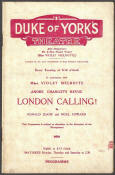
A Duke of York's Theatre playbill from 1923. The playbill for Madame
Sand would have looked like this one. |
Madame Sand is a biographical comedy about the French novelist
best known by her pen name George Sand (1804–1876). She was one of the most popular writers in Europe and well known for
her affairs with men such as the poet Alfred de Musset and composer Fredric Chopin.
Jules Sandeau, one of her earliest lovers, inspired her choice of pen name.
For about five years all Paris was talking about
the love affair of Alfred de Musset and George Sand, which lasted from summer
1833 through March 1835. Though much was rumor and speculation, one fact
alone was certain. They had gone to Italy together, and had come back
separately. But what happened to them? De Musset
wrote his own version of the story in the Confession d'un Enfant du Siècle.
Sand replied by writing her own
version, called Elle et Lui. After Alfred de Musset had died, his brother
Paul took it upon himself to defend his brother's memory in yet another version
of the story, called Lui et Elle. In this version Paul professed to write the story as he had heard it from
Alfred's own lips.
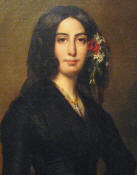
A
painting of George Sand, 1838 |
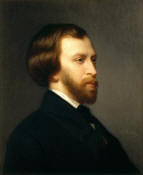
Alfred De Musset, 1854
painting by Charles
Landelle |
These facts are known: that George Sand was successively the
mistress of Sandeau, de Musset, Pagello, and Chopin; that she smoked and wore
trousers in days when this was unusual for women; that she wrote a large
number of novels, and that these novels were chiefly based on her own experiences.
Philip Moeller has taken these few facts and woven them into a play that deals with three of George Sand's love affairs, one act per
affair. When the curtain goes up we are in the midst of the affair with de Musset. Overwhelmed by the arts of George Sand,
Madame de Musset withdraws her opposition to the flight of her son with his
mistress to Italy. The pair depart. Act II shows the lovers tired of each other,
and George in the situation of ridding herself of the old love by the simple
process of going off with the new. Act III depicts her surrender of Dr. Pagello to
his previous girlfriend, and Sand's conquest of Chopin.
Madame Sand was written for Mrs. Fiske (American actress, 1865–1932),
who describes it in a foreword to the printed copy of the piece as a
"brilliant and funny play." She laughed and laughed as she read
it. The play had its first performance in Baltimore
in October 1917, and great success followed. The play opened in London on June
3, 1920, with Mrs. Patrick Campbell playing George Sand, and Basil Rathbone
playing Alfred de Musset. Reviews were mostly negative, although some critics
liked the play.
The Aberdeen Press and Journal (June 16, 1920) reported: "Mr. Moeller, an American dramatist, terms his comedy in all earnestness a
'biographical comedy,' but in truth it has none of the elements of comedy in it.
It is a romantic farce, in which the characters are travesties, extravagant,
strutting stage presentments of the originals. ... George Sand was a pioneer, the first woman to stand alone, defy the public
opinion of her time with the courage of her convictions. The fact that the lady
preferred the comfort of loose trousers to the hampering skirts then in fashion;
smoked cigars, and gave full rein to her passion for intellectual and 'daring'
conversation; had a liberal taste for men and a large-hearted capacity for love
scarcely justifies any author in making her cut so ridiculous and preposterous a
series of capers as Mr. Moeller depicts in Madame Sand."
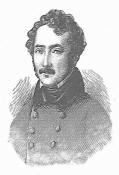
Pietro Pagello |
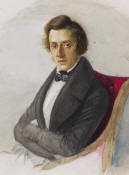
1836 watercolor portrait of Polish composer Frederic Chopin painted by
then-16-year-old Maria Wodzinska (1819-96) |
Many critics of the play denounced it for not portraying the real George Sand.
One critic claimed that it might have been a fascinating study of
George Sand if the playwright, Philip Moeller, had taken his subject seriously.
The Sporting Times (June 12, 1920) reported, "Moeller's treatment is flippant, bordering on the farcical. His tone is
mockingly humorous—a satire,
principally, on the literary temperament. The motive of George Sand's numerous
amours with famous men—Chopin, de Musset and the rest—does not concern the
author. Was it merely sexuality, or the ungratified longing for reciprocated
affection?"
"The George Sand of the comedy is not in the least the George Sand of
literary history. One is quite sure that that famous woman never stopped in
the midst of her impassioned moods to turn them into 'copy.'" —The
Sphere, June 12, 1920
Regardless of the critics' complaints, audiences seemed to enjoy the play.
"The presentation here of Philip Moeller's so-called
comedy 'Madame Sand' has met with disapproval, the London writers being very
much upset over his methods of presenting the unfortunate love affairs of the
great novelist. While the greater number of the actors were kindly treated, the writers tore
the play apart. Evidently, they don't like American frankness in disclosing the
more unpleasant histories of their favorite public writers. Nevertheless, the facts recorded are matters of history and whether the
writers like it or no, it is apparent that the play will remain, for audiences
seem to be very partial to the piece." —New York Clipper, 30 June 1920
"Mr. Philip Moeller's play is a very able piece of work. ... Mr. Moeller has
managed so well and Mrs. Patrick Campbell and Mr. Basil Rathbone contrive such
exquisite performances that 'Madame Sand' may be given high recommendation."
—H.F., The Daily Herald, June 4, 1920
The following review of Madame Sand was written by a young theatre
critic named Aldous Huxley. He later became a famous novelist, perhaps best
known for writing Brave New World (1932).
Madame Sand I am so grateful to Mr. Moeller for his cleverness, his good taste, and his
knowledge of literature, that I am chary of criticising his play, for fear it
should be thought that I did not like it. But criticise one must—criticise,
like the father when he spanks his son, for the play's own good. So here goes.
The principal, the only serious, defect of
"Madame Sand," is that it is too long by fully an hour. there were longueurs,
there were repetitions; the situations were stretched to breaking point. this
congenital weakness the actors increased, especially in the first act, by taking
the piece with a funereal slowness. But a first night is always experimental,
and it is to be hoped that in the future the pace will be quickened and the play
itself ruthlessly cut. Scraped of its hampering barnacles, and of its
top-heaviness, "Madame Sand" should be able to affront a long voyage a light and
elegant little ship. Left as it is, it will as likely as not turn turtle and
sink at once.
"Madame Sand" is a satire in dramatic form a
satire on the great George herself, and a satire on romanticism in general. It
is not difficult to satirise George Sand; indeed, she is probably the most
easily satirisable figure in history. The thing has been done to absolute
perfection in Charles Maurras's brilliant study of the George-Alfred episode,
"Les Amants de Venise," a book from which, we imagine, Mr. Moeller must have
derived the principal inspiration of his play. George, with that unappeasable
maternal instinct of hers, that infinite capacity for indiscriminate passion,
that sensibility mingled with coarseness, that fantastically grotesque
romanticism, George is her own caricature. The satirist does not have to
brighten the colours; he actually finds himself toning them down. The
conversation of George and Aflred, in the first act, may seem a little
high-flown, but it is nothing to the language of their published letters.
George's explanations of her infidelities as Higher Duties, directly inspired
from above, were even more amazing in real life than they are in the play.
Mr. Moeller has chosen as his theme the unlucky
story of George and Alfred de Musset. We are shown in the first act George's
rooms in the Quartier Latin. She is giving a farewell supper—farewell to whom is
still a little uncertain; it may be farewell (eternally) to Alfred, or it may be
farewell to Paris, while she goes off with him to Italy. By the end of the act
it is the latter. George has persuaded Mme. de Musset to let her son go with her
(this is a scene which deserved more length, at the expense of the rest of the
act, than it got); Buloz of the Revue and Heine are bidden farewell, and the
happy pair are off to an Italy, where it is always moonlight and the
nightingales perpetually sing.
Act Two shows us George and Alfred's apartment
in Venice. Alfred is ill in bed—delirium tremens complicated by sunstroke, a
touch of malaria, and the fatigue of frequent debauches. George has heroically
nursed him for nearly twenty sleepless nights; the fact that he is alive at all
is entirely due to her maternal devotion. But her devotion to Alfred has not
prevented her from noticing the appearance of the young, handsome, and ox-like
Venetian doctor, Giuseppe Pagello. ... Honest Pagello had no chance. Farewell
Alfred! And Alfred, who had watched the whole scene between the curtains of his
bed, becomes a little bitter and cynical. (In real life his bitterness and
cynicism did not begin till much later. For months after the Pagello incident he
wrote her passionate love letters, and for a little while, in Paris, they met as
lovers once more. His chronic hysteria again made a joint existence impossible,
and the candle of passion finally guttered out with a great deal of
evil-smelling smoke. Mr. Moeller has chosen, for his own dramatic purposes, to
make the rupture between George and Alfred complete as soon as Pagello appears
on the scenes.)
In the last act Pagello is got rid of. He has
been brought to Paris, where his naturally bovine qualities are thrown into
strong relief by the intelligence of George's friends. George, unable to bear
him any longer, sends for his old mistress from Castel Franco to come and carry
him away. Which she does, leaving George free to look elsewhere. "The lions
roaring after their prey do seek their meat form God, and He giveth it them in
due season." It is at this moment that Chopin enters providentially upon the
scene. The curtain falls on their elopement to an island in the Mediterranean.
"How long this time?" Buloz asks Heine. And a romantic young lady who picks up
George's farewell not e exclaims in rapture, "How beautiful!"
Mrs. Patrick Campbell made an enchanting George,
a George of whom one could feel that she was, in spite of everything, a great
woman. Mr. Basil Rathbone's Alfred de Musset and Mr. Ivan Samson's Chopin
were both sound performances. Mr. Edgar Kent and Mr. Frank Cellier, as Buloz
and Heine respectively, were chiefly responsible for the slowness of the first
act. A slight acceleration would improve the acting of both. Scenery and
costumes were excellent.
A. L. Huxley
—The Westminster Gazette,
June 4, 1920
|
"Mrs. Pat Campbell has substituted Philip Moeller's 'Madame Sand' for Shaw's
'Pygmalion' at the Duke of York's, where the play has been quite favorably
received. Among those present at the premiere was Mr. Moeller, who, when he
learned that Mrs. Campbell was rehearsing his play in London, miraculously
obtained both passport and passage in the space of a few days."
—The New York Times, June 20, 1920
"The play is entertaining hearing, and still
more agreeable reading. Its many good lines, especially the sarcastic
comments of Heine, may possibly be inspired by the actual sayings or
writings of Heine, de Musset, Chopin, and Liszt, all of whom appear in the play,
admirably portrayed by, respectively, Frank Cellier, Basil Rathbone, Ivan
Samson, and Hector Abbes. Rathbone, perhaps, is the best of the excellent
quartet. His effeminate de Musset is a perfectly drawn creation, and one of his
'moments'—an outburst of hysterical laughter (a most difficult thing to
do)—stamps him as an actor of more than merely exterior charm, in which useful
quality he is singularly blessed. Maybe we have in Rathbone a future George
Alexander or Henry Ainley. What a Romeo he would make!" —The Sporting Times, 12 June 1920
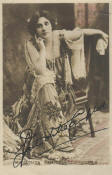
Mrs. Patrick Campbell (in 1909), who played the role of
Madame Sand |
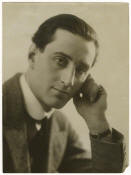
Basil Rathbone (in 1920), who played the role of
Alfred de Musset
(photo by Bassano, from the National Portrait Gallery) |
"Mr. Moeller is to be congratulated chiefly on the excellent acting material
he has given to Mrs. Patrick Campbell and Mr. Basil Rathbone. They pose to each
other divinely, in an everlasting contest of wits in which he is
everlastingly beaten. ... De Musset, like so many poets, sought inspiration in love; he
fertilised the female genius, but became sterile in his own creative activity.
There is possibly no hatred so intense as that with which a barren artist
contemplates a fruitful one; and when the fertile genius is one's lover, we have
divine comedy indeed. Mr. Basil Rathbone played it with wonderful skill; he not
only made de Musset intelligible, he helped to explain Madame Sand. Actually she
vampirised him; although she gave as much in quantity, nay, more, than she
received, it was useless to him. He transmitted the creative impulse—and got
her creations in return; while she could communicate no impulse to him, on the
contrary, she inhibited his creative powers. His joy when she left him, and his poetive power reasserted itself, was probably his only heartfelt emotion; but he
provided much delicate comedy by his posing, and attempting to get 'copy' from
his posing, before he reached this conclusion. It was the most considerable
performance I have seen by Mr. Rathbone; it marks him as a subtle actor of
emotional states and psychological interpretation. In the first act he made us
see de Musset stripped of everything but the artistic temperament, and posing to
preserve his reputation; but in the second act he made the return of his power
as real as Pentecost, we could see his genius inform him as he wrote." —John Francis Hope, The New Age,
June 24, 1920
"Basil Rathbone's rather an attractive thing to look upon, isn't he?—but
he's overshadowed just a bit. The part of Alfred de Musset doesn't suit him half
as well as Peter Ibbetson." —The Tatler,
June 30, 1920
| "Madame Sand" at the Duke of York's "Don't destroy my illusions!" is a golden saying which I would frame in
everybody's mental chamber, for illusions are half the charm of life. I thought
of this when I saw the "Madame sand" play at the Duke of York's Theatre. It is
not an unskillful play in its way, nor should it be approached with a high brow;
it is simply bold journalism in the best American sense. ... I had the feeling
that Mr. Moeller knew very little of the souls of his characters, and a great
deal of their clothes and their mannerisms, as handed on by newspaper gossip of
the time, or by memories—which mostly turn
molehills of events and sayings into mountains of vital importance.
But let all that pass: it is a great task to transplant to the stage those
who are almost contemporaries. ... With all its faults, this Sand play is far
more interesting than a dozen others now running in London. It stimulates
imagination. You have but to scan the characters: Musset, Chopin, Liszt, and
Buloz! ...
But where Mr. Moeller fails is in despoiling us of our illusions. George Sand
was not a regular courtesan, in breeches and smoking big cigars, with the
instinct of an interviewer who says at every good thing he hears: "Capital
copy!" and marks it down. She was an amoureuse of high culture, a charmer
of men more by the word even than by her graces, a thinker, a plodder, a worker;
one who worshipped form and style, and would polish her work in wakeful nights
until it glitters like flawless brilliants. In the play she is merely farcical—Quartier
Latin reminiscent of Murger's Mimi. As for De Musset, though he was enacted as
beautifully by Mr. Basil Rathbone as George Sand by Mrs. Patrick Campbell, was
he merely wormwood and wishywashyness? Was there nothing of the poet in him in
his intervals of control? The main vision of the play is the spectacle of a man,
evidently recovering from a night of cups, emerging from a four-poster [bed]
while his mistress is making love to his doctor. To think of it, and then to go
to the bookshelf and pick a volume of the "Nuits"! Again, to think of Heinrich
Heine (another cameo of acting), distinguished of tongue, yet with a penchant
towards gluttony, and the table manners entirely foreign to one so refined in
taste, so critical others, so wholly Parisianised that he transformed his own
language to unapproachable grace! to think of Liszt, the dreamer, the charmer,
the ethereal, the exquisite courtier, re-moulded by the dramatist into a comic
busybody, and thus played by Hector Abbas with real humour! There is but one
whom we meet without feeling the pain of destroyed illusions. That was the
Chopin, a picture in Mr. Samson's delicate emotion. Here, at length, we felt
what might have been if Mr. Moeller had applied imagination instead of craft.
... Yet we came away in a strange spirit of disappointment, in spite of having
been entertained. The play had rent our illusions.
J.T. Grein
—The Illustrated London News, 19 June 1920
|
"Mr. Moeller ... finds most inferior comedy in the business from the very
start and pursues it the length of his three Acts. We simply fail to recognize
this George, who cannot even at the gravest crisis speak or hear an effective
phrase without scribbling it down at once for copy; who 'blarneys' the mothers
and fathers of her victims like the adventuress of an old-fashioned Irish novel,
and who snares and dismisses her lovers with the cynical detachment—shall we
say of a Guitry heroine? Not all the painstaking accuracy of detail—not
the trowsers, nor the cigars, nor even the famous tea-cup of the revelation
scene at Venice—can make her plausible for a
single instant. George Sand erred in the main through excess of sincerity; this
creature seems never to be sincere at all. If it was desired to display a suave,
elegant and artificial coquette it was right to engage Mrs. Patrick Campbell to
play the part, since nobody else can hit off such characters with a tithe of her
humour and mastery. It is always delightful to watch Mrs. Campbell act, but why
drag in George Sand? The author is a trifle more successful with some of the minor characters. The
Alfred de Musset, indeed, is poor, despite Mr. Basil Rathbone's fine
performance. We get the absinthe and the nerves without the genius, and to make
Alfred abet the amours of George and the Doctor in order to get rid of her is
surely false both to the facts and his character."
—The Athenaeum, June 11, 1920

Mrs. Patrick Campbell as George Sand |
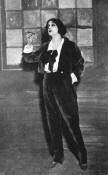
Mrs. Patrick Campbell as George Sand |
"Mr. Moeller takes as his central incident the affair between George Sand and
de Musset. He strips it of all truth and passion, presenting it as an encounter
between two incorrigible poseurs. George Sand must fancy herself in love in order
to write her novels. She makes phrases wherever she goes, and will interrupt her
most impassioned adventures to jot something down upon her tablets. Having wrung
out of de Musset the last possible drop of 'copy,' she makes love to his doctor.
Mr. Moeller's treatment of this incident is characteristic. The Dr. Pagello of
history was a man of considerable intellect and character. ... A contrast between this practical and honourable
man of solid worth, losing his head for the moment, but soon retrieving it
undamaged, a man of science, presumably a realist and something of a
Philistine, and the Bohemians of a period when there were giants in Bohemia,
would have made a fascinating drama. ... Mr. Moeller makes no such effort. His Pagello
is simply a bigger ass than the rest, an ass, too, who consents to run away with
his mistress with the help of funds supplied by her former lover, who is only
too anxious to be rid of her. This, apparently, is Mr. Moeller's idea of a joke.
Such an incident would only be tolerable, if presented with the sincere savagery
of Swift, or the strong irony of the author of 'Jonathan Wild.' As a mere
excursion in burlesque, it is needlessly offensive and has the additional
disadvantage of being wholly untrue." —The Saturday Review, June 19, 1920
| MADAME SAND Do not hitch your wagon to a star if that vehicle has only three wheels. Mr.
Philip Moeller has certainly a facility for dialogue. He can make a joke, which
is not a common faculty, but in Madame Sand he has been completely overwhelmed
by the effulgence of his characters—Liszt, Chopin,
Heine, Alfred de Musset, and George Sand. When the play was acted the audience
was left with the impression that the author had been so completely
bouleversé by his high company that he had merely brought his characters on
to the stage and hoped that once there they would do themselves justice. Pious
aspirations do not make a play, and yet, though it is not quite a play, though
it is not a little dull, it was not unpleasing as produced by Mr. Fagan. The
costume, for one thing, was attractive, and in the book we perceive a quantity
of moderately good epigrams. The idea of the play is to display George Sand as
an amiable impulsive Tank, able to override the remonstrances of a mother and
the reluctance of three lovers—one lover per act. She simultaneously loves,
sups, packs, and writes novels. Thus: tender pressure of the hand and melting
glance; bite of omelette (with left hand); sentence describing unhappy past,
inscribed in current novel with quill pen (right hand); excursion to pack shawl;
repeat.
Though crushed under the weight of his characters, Mr. Philip Moeller remains
a potential dramatist, but when next he writes a play, let him invent his
characters for himself, a feat of which he is obviously perfectly capable. The
actors at the Duke of York's suffered from the dullness produced by the
flattening out of the dramatist. They made heroic efforts, but they seemed to
move and speak with something of the frantic energy, the ill-success, the
muffled tone of those who struggle under the folds of a collapsed tent. Even
Mrs. Patrick Campbell's vigour did not quite suffice. However, the acting, like
the play, though ineffectual, was not altogether unpleasing; at least, the play
will send those who have read or witnessed it in search of La Petite Fadette
[a novel written by George Sand]
at the London Library. It did not deserve a longer run.
Tarn.
—Spectator, July 3, 1920
|
"The ensemble of Madame Sand has been aided greatly by the costumes of the
period and by the scenery, tastefully designed by Mr. Fagan, and painted by J.
Fraser and W. Hann. There is no doubt that such success as may be gained here by
the poor play into which Mr. Moeller has let fall what might have been a fine
and ennobling, instead of alternately rhapsodical and farcical one, should be
attributed to the admirably effective acting given by Mrs. Patrick Campbell. She
plays mainly on the semi-burlesque lines and with the showy business apparently
required by the author, except in some of the more serious passages with Alfred
de Musset, Heine, Pagello, and Chopin the second and fourth delineated with
gravity and impressiveness by Mr. Frank Cellier and Mr. Ivan Samson, and the
others also with a certain amount of the polish, finesse, and distinction
essential by Mr. Basil Rathbone and Mr. Hubert Harben." —The
Stage, June 10, 1920
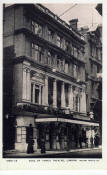
The Duke of York's Theatre in 1892 |
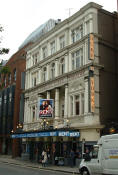
The Duke of York's Theatre in 2007 |
"The thing may be a farce, but it is a very
delightful one. ... On the whole, there was much good acting
in the play. Miss Haidee Wright was really good ... All these characters
suffered, like Mr. Basil Rathbone, from the fact that they were forced to
represent people of whom the audience already had a preconceived idea. Mrs.
Patrick Campbell alone came unscathed through the ordeal. What did it matter if
she was not like George Sand if only she would go on acting." —The Woman's Leader,
25 June 1920
| THE PASSING SHOWS Duke of York's Theatre.
To draw the literary portrait of a genius and not make that "genius" half
idiot, half ass; to act the part of a genius and not accentuate these lunatic
qualities—that is a most difficult achievement,
both for author and for actor. Nor has Mr. Philip Moeller succeeded where so
many others have failed, in spite of the really brilliant performance of Mrs.
Patrick Campbell in the title role. His new play, Madame Sand, produced
the other evening by Mr. J. B, Fagan, is but the caricature of a real personage.
He has merely seized upon the weaknesses of George Sand, elaborated them,
exaggerated them, until they are the most overwhelming feature of her character.
His heroine is inordinately vain, unscrupulous, hypocritical, absurd—anything
but the genius which the woman she is supposed to be, undoubtedly was. In fact,
the stage is filled by famous men—most of whom are the veriest puppets
masquerading under historical names. Thus we have a neurotic "ninny" calling
himself Alfred de Musset; a kind of fussy second-rate bandmaster pretending to
be Franz Liszt; an utterly heavy and commonplace Heine; a kind of "butler" in
disguise, by name "Buloz," and a rapturously sentimental feminine absurdity
pretending she is George Sand. Indeed, the only one who shows even a flicker of
"genius" is Frederic Chopin; perhaps because he is very well acted by Mr. Ivan
Samson. But Chopin only appears at the very end, though in the most moving scene
of the whole play. For the rest, it is all sheer farce pretending to be
historical fact. And if you can forget that the names of the men and women who
make us laugh—not with them, but at them—are names great in the
world' artistic history, you will doubtless be amused. But most who laugh will
thank heaven for that obscurity in which they live, an obscurity which will
eventually save them from biographers, and from dramatist wishing to exaggerate
a few of their minor failings until they appear veritable "figures of fun" to
posterity. Death is bad enough, but to be burlesqued after death—that surely is
adding a pint of vinegar to a pound of salt.
George Sand and Her Lovers.
From our obscurity, however, we can well afford to laugh at Philip Moeller's
picture of George Sand and her lovers. It is all quite good fun. It is all the
better fun when you know that half the woman's absurdity at which you laugh
isn't true—or only merely a suspicion of the truth.
What historical data has the dramatist to go upon, for example, when he makes
George Sand break off suddenly in the midst of each one of her passionate
moments to write down on paper what she has just uttered for insertion in her
forthcoming book? From where, too, did he obtain the knowledge that, when George
Sand tire of the good, commonplace Italian doctor, Pagello, she sent for his
late mistress and provided the funds by which the doctor and the girl were
packed off back to Venice? Of course it's all very amusing, and dovetails
admirably with the incident of the 1,000-franc note which Pagello and George got
out of Alfred de Musset when he provided the funds for them to leave Venice in
the first instance. But we are supposed to be dealing with historical
accuracy—otherwise, why drag in George Sand? Any silly woman would have done
equally as well, and her absurdity would not have tainted the memory of a writer
who, in spite of all her supreme egotism, was at any rate a writer of genius.
Indeed, if the real George Sand ever appeared in Mr. Moeller's play at all, it
was in the last scene, between herself and Chopin, wherein the woman who was
always searching for the ideal lover and ideal friend realised at last that they
were all part of the self-deception by which the human heart lives and hopes;
that all men and women must pass through this world, always looking for their
ideal mate, yet always ... always lonely, and never so lonely as at the end of
life. Chopin, too, is tired—tired of the applause and the crowd which lies in
wait for him to do him empty homage. So these two meet, and for a short time
they believe that they have found Paradise in each other's arms. But, of course,
it will only be "for a time"—that's what makes the audience laugh so much. Love
is one of the practical jokes which Fate plays on the human heart. And everybody
can see the fun of a practical joke when they themselves are not the victim.
even the victim can laugh at it later on, years afterwards, when the shock and
absurdity are forgotten, and they only see, as it were, an incident in which
someone calling themselves by their own name figured so disastrously.
The Acting.
Mrs. Patrick Campbell's George Sand was the dramatist conception to the life.
Her own delicious sense of humour found a free play in this character of a
hundred absurd affectations, a hundred fond illusions. In the last scene with
Chopin, however, she played with a sadness, a tenderness, with that touch of
spiritual weariness which comes so often with middle-age, after a life of
searching and never finding, which was beautiful in the extreme. This is the
most moving scene in the whole play It was the most perfectly acted, too, by
both Mrs. Patrick Campbell and Mr. Ivan Samson. It is a beautiful end to a play
which is quite amusing when you can forget that the author is filling his stage
with famous people, and making them speak together in a language closely
approaching the modern American idiom. Mr. Basil Rathbone as Alfred de Musset
tried his best to give colour to a part which was essentially colourless. The
rest were as the author had draw the characters—and
this gave them but little scope. But Miss Florence Saunders was vividly
tempestuous as Pagello's discarded mistress—though even she was more like an
East End 'Arriet in a furious temper than a heartbroken Italian cocotte.
The scenery and the dresses were quite charming in their old-world Fashion.
Madame Sand will never be satisfactory as an historical play, but it is very
amusing as a quiet farce.
—The Tatler, June 23,
1920 |
|


















